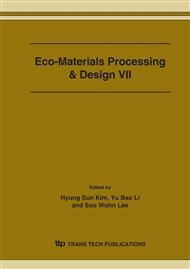p.242
p.246
p.250
p.254
p.258
p.262
p.266
p.270
p.274
Development of Cube-Textured Ni and Ni-W Alloy Tapes by Focused Infrared Heating
Abstract:
We fabricated bi-axially textured pure Ni and Ni–5at.%W (Ni-5W) alloy tapes for the application of rechargeable battery cathode and coated superconductor, where the controlled microstructure of the substrate plays a critical role. The sintered Ni or Ni-W rods were cold-rolled into the thin tapes of 80 ~ 100 µm thickness, and the tapes were heat-treated for texture development with a line focused infrared heater. The temperature was maintained at 800 ~ 1050 °C, using a 1kW double ended linear halogen lamp in 96%Ar-4%H2 atmosphere. The (2 0 0) texture of Ni tape was successfully formed through optimization of the recrystallization infrared heating condition for the cold rolled Ni tapes. The full width half maximum of the Ni tapes was less than 10o, and the grain size was 20 ~ 40 µm. Focused IR-heating resulted in a better texture development and smaller grain size compared to the conventional resistive heating because of the steep temperature gradient.
Info:
Periodical:
Pages:
258-261
Citation:
Online since:
March 2006
Authors:
Price:
Сopyright:
© 2006 Trans Tech Publications Ltd. All Rights Reserved
Share:
Citation:


